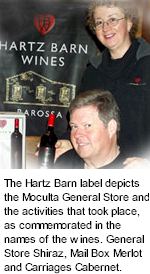


The Barossa is recognised throughout Australia as a vital part of the nation's heritage and is an important wine and tourist region. Explorers and settlers were attracted to the Barossa very soon after the settlement of South Australia in 1836. George Fife Angus conducted a program of assisted immigration that was to have lasting effects on the character of the Barossa. The largest group was German Lutherans who came to South Australia in 1838-1841, seeking to escape religious restrictions in Prussia. This strong German influence is reflected in the immaculate Lutheran Churches spread throughout the Barossa landscape. Along with them, British immigrants arrived to add diversity to the settlements and commence farming, grape growing and winemaking.

The home of Hartz Barn Wines has supported the families of the district as a General Store, known as Hentschke General Store, since 1885 offering an extensive range of goods and services. Prior to white settlement the Moculta district was peopled by Aboriginals, the Ngadjuri and Peramangk were in the area at one time. Moculta is the Aboriginal name for large hill and is a reference to Parrot Hill. Moculta carries a strong heritage in that it was for a century predominantly German, although the first settlers were English. These settlers formed a community strongly linked to their German and British heritage.
Two Lutheran churches serve Moculta, Gruenberg and Gnadenberg, German for green hill and hill of grace, respectively. The Gruenberg Holy Cross Lutheran Church is built on top of a hill and known for the timber locally handcrafted organ and displays elaborate painting and German verses. Standing opposite the Henschke Hill of Grace Vineyard is the Gnadenberg Zion Lutheran Church built of local stone and huge pit sawn beams from local red gum.
The Hartz Barn label depicts the Moculta General Store and the activities that took place, as commemorated in the names of the wines. Hartz Barn General Store Shiraz, Mail Box Merlot and Carriages Cabernet. What is unique about these efforts is how well the powerful fruit and tannins have been handled and elegance achieved.
Hartz Barn's Dennistone Vineyard is planted on phylloxera resistant vine rootstock with the varietal clones being selected to produce premium wines that are full flavoured, balanced and distinctly display their Barossa heritage. Dennistone is planted to Merlot, Shiraz, Cabernet Sauvignon, Riesling and more recently La Grein. The vineyard is situated close to the map references of Henschke's Hill of Grace and Mount Edelstone vineyards.
The property is 359 metres above sea level and receives 480 mm of rainfall in most years. Soils are loam over red brown friable clay subsoils that are very productive, well structured and free draining. Warm to hot summer days associated with cool evenings facilitates the extended grape ripening period. These elements combined with carefully managed ground moisture monitoring produce the balanced and flavoursome premium wines. Hartz Barn hand pick all their grapes before crushing and fermentations in open vats, followed by basket pressing and malolactic fermentations. All Hartz Barn red wines are matured for at least 12 months in barrels made from American and French plantation oak timber.
